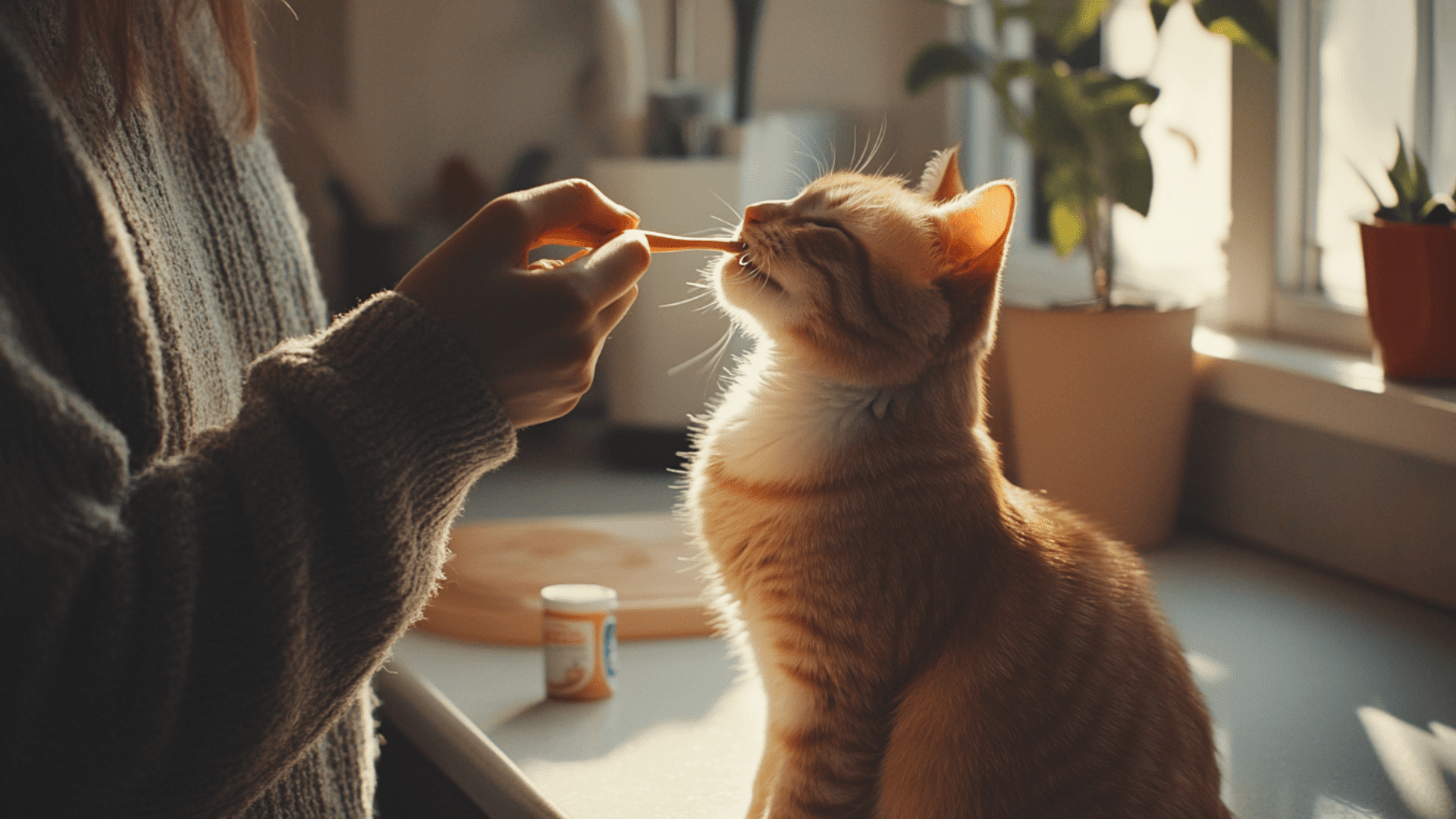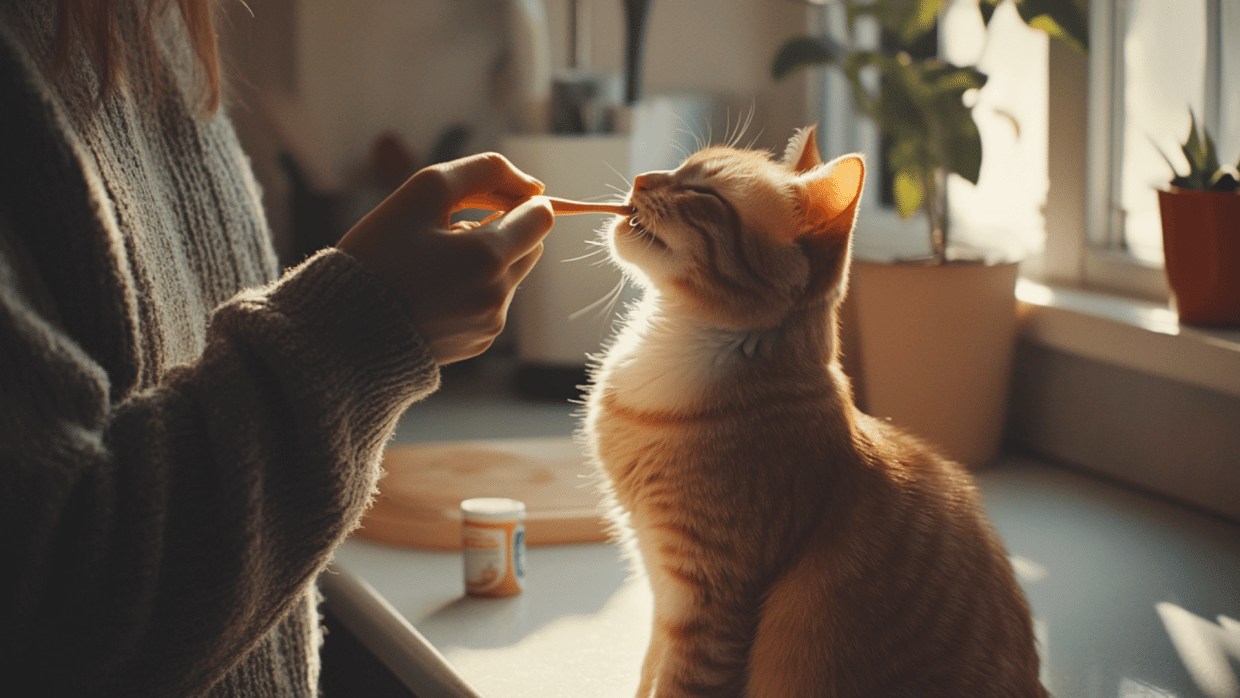
- arrow_back Home
- keyboard_arrow_right Cat Care & Grooming
How to Clean Your Cat’s Teeth

Cat Care & Grooming Joanna Tate April 25, 2025
Ever tried brushing your cat’s teeth and ended up with a scratch or two? You’re not alone. Cleaning a cat’s teeth can feel impossible, especially when they squirm, hide, or clamp their mouth shut.
But skipping dental care can lead to serious problems like bad breath, tooth loss, and even health issues down the line.
This guide breaks down how to clean a cat’s teeth in a way that’s easy, stress-free, and doable at home.
You’ll learn what tools to use, step-by-step tips, smart tricks for stubborn cats, and simple ways to keep their teeth healthy long term.
Want to know a brushing hack most cat owners don’t try but should? Let’s get into it.
Why Cleaning Your Cat’s Teeth Matters
Skipping dental care might not seem like a big deal until it is. Many cats hide pain, so issues can sneak up fast without clear signs.
Oral Diseases Common in Cats
Cats can develop problems like:
- Gingivitis: Red, swollen gums caused by plaque
- Periodontal disease: An Infection that damages the gums and bones
- Tooth resorption: A Painful condition where the tooth starts breaking down
These can all lead to pain, bad breath, and even tooth loss.
Long-Term Health Impacts
When plaque builds up in your cat’s mouth, bacteria can enter the bloodstream. Over time, this bacteria can affect important organs like the heart, kidneys, and liver.
These health problems don’t always show up right away, which makes prevention even more important.
Keeping your cat’s teeth clean can help lower the risk of these serious issues. It’s one of the simplest ways to support their long-term health and comfort.
When to Worry
Some signs of dental trouble are easy to miss, but there are a few red flags to watch for. Bad breath, drooling, or pawing at the mouth can all mean something’s wrong.
If your cat has trouble eating or you notice red, swollen, or bleeding gums, it’s time to call the vet. Regular brushing and early care can help you avoid these painful problems down the road.
Can You Skip Brushing? (Spoiler: You Shouldn’t)
Brushing might seem optional, but it’s actually one of the most important things you can do for your cat’s health. A lot of owners skip it, thinking it’s unnecessary or too hard, but that can lead to bigger problems down the line.
Myths and Misconceptions
Some people believe that dry food or dental treats are enough to keep a cat’s teeth clean. Others think cats don’t need brushing because wild cats don’t get it.
But domestic cats eat softer food and don’t chew the way wild cats do. That means they need more help keeping their teeth clean.
Dental toys and treats help a little, but they don’t replace brushing. Even if your cat hates it at first, brushing is still worth it in the long run.
What Happens if You Don’t Clean
If you skip brushing, plaque builds up on your cat’s teeth. Over time, that plaque hardens into tartar, which irritates the gums and causes pain. This can lead to gum disease, infections, and even tooth loss.
Not sure what tartar looks like or how to handle it? Check out our full guide on tartar on cats’ teeth to learn what to watch for and how to treat it early.
Left untreated, dental issues can become serious and costly. Regular brushing helps prevent these problems and keeps your cat healthier overall
Brushing Basics: What You’ll Need
Before you start brushing your cat’s teeth, it helps to have the right tools. Using cat-safe products makes the process smoother and keeps your pet safe and comfortable.
Finger Brush vs. Pet Toothbrush
A finger brush is a soft rubber tool that fits over your fingertip. It gives you more control and is great for beginners or cats that are nervous. A pet toothbrush has a longer handle and angled bristles, which can help you reach the back teeth.
Try both to see which one your cat prefers. Some cats do better with one over the other.
Cat-Safe Toothpaste Only (Never Human Toothpaste)
Always use toothpaste made for cats. Human toothpaste contains ingredients like fluoride and xylitol, which are dangerous if swallowed. Cat-safe toothpaste comes in flavors like poultry or tuna, making it more appealing for your pet.
Never force human products on your cat; it’s not worth the risk.
Gauze and Dental Wipes
If your cat won’t tolerate a brush, gauze or dental wipes can be a good backup. Wrap a small piece of gauze around your finger and gently rub it along the teeth. Dental wipes are pre-moistened pads made for pets and can help remove surface plaque.
These are great stepping stones if your cat needs time to get used to brushing.
How to Brush Your Cat’s Teeth: Tips

Brushing your cat’s teeth doesn’t have to be a battle. Start slow and ease your cat into the routine with patience and positive vibes. This plan helps both you and your cat get comfortable, one small step at a time.
Day-By-Day Introduction Plan for Beginners
Use this simple 5-day plan to build trust and comfort:
Day 1. Sniff: Let your cat smell the toothbrush and toothpaste. Reward with a treat.
Day 2. Touch: Gently rub your finger along your cat’s gums. No brushing yet, get them used to the feel.
Day 3. Taste: Put a small dab of toothpaste on your finger and let your cat lick it.
Day 4. Practice: Use the toothbrush or finger brush to touch the front teeth for just a few seconds.
Day 5. Brush: Gently brush a few teeth at a time. Gradually build up to the full mouth over a few days.
If your cat gets overwhelmed, go back a step and take it slower. The goal is progress, not perfection.
What to do if Your Cat Resists
If your cat pulls away or hides, don’t force it. Stay calm and try again later. Use treats, soft praise, or petting to create a positive experience. Brushing should never feel like a punishment.
Even if you only manage a few seconds at first, that’s okay. Every bit helps.
Positioning Tips and Voice Tone
Sit on the floor or hold your cat in your lap, facing away from you. This makes them feel more secure. You can also wrap them in a towel if they tend to squirm.
Speak in a calm, soothing tone. A gentle voice helps keep your cat relaxed and builds trust.
Alternatives to Brushing
If brushing isn’t an option for your cat, don’t worry, there are other ways to help keep their teeth clean. These methods aren’t as effective as brushing, but can still make a difference when used regularly.
1. Dental Gels: How to Apply
Dental gels are easy to use and don’t require brushing. Just apply a small amount to your cat’s gums or teeth using your finger or a cotton swab. The gel works on its own to break down plaque and freshen breath.
Some gels come in flavors your cat might enjoy, making the process smoother.
2. Dental Chews and Toys
Chewing helps reduce plaque buildup by scraping the teeth naturally. Look for cat-safe dental treats or rubber toys designed to promote oral health. Many are flavored to encourage chewing.
Give these regularly, but don’t use them as a complete replacement for brushing.
3. Raw Bones
Some people offer raw meaty bones like chicken necks to help clean their cat’s teeth. While this can work for some cats, it comes with risks, like choking or bacterial infection.
Always talk to your vet first before trying this option. Not all cats are suited for raw bones.
4. Diet Considerations
What your cat eats affects their dental health. Dry kibble may help a little by reducing soft food buildup, but it’s not a cure-all. Some prescription dental diets are specially made to reduce plaque and tartar.
Ask your vet if a dental diet could be a good fit for your cat.
Professional Dental Cleaning: What to Expect
Sometimes home care isn’t enough, and a vet visit is the best way to handle serious dental issues. Here’s what you should know before scheduling a professional cleaning.
Cost Overview
In the U.S., a professional dental cleaning for cats typically costs between $100 and $700.
The exact price depends on factors like your location, your cat’s health, and the severity of dental issues. The price often includes anesthesia, X-rays, scaling, and polishing.
If extractions or additional treatments are needed, costs can exceed $1,000. Ask for an estimate ahead of time so you can budget for the visit.
Risks and Benefits
The main risk comes from the anesthesia, especially for older cats or those with health issues. Vets take precautions, but it’s still something to consider.
The benefits are strong. A professional cleaning removes tartar below the gumline, helps prevent infections, and can save teeth that might otherwise be lost. It also gives your vet a chance to spot hidden problems early.
Frequency Based on Age/Breed
Most cats benefit from a professional cleaning every 1 to 2 years. However, some breeds like Persians or Siamese are more prone to dental issues and may need cleanings more often.
Your vet can recommend the best schedule based on your cat’s age, breed, and overall health.
Cat Brushing Hacks: Make it Routine
Brushing gets easier when it becomes part of your cat’s daily rhythm. These simple tricks can help make the experience smoother and more positive.
Positive Reinforcement Tips
Use these ideas to build trust and reward good behavior:
- Treats: Offer a favorite snack immediately after brushing
- Praise: Speak softly and use a happy tone during and after
- Play: Follow up with a quick play session to keep the mood light
- Touch: Gentle petting can calm nerves and reinforce trust
- Patience: Stop if your cat gets upset and try again later
Pairing With Feeding Time
Link brushing to meals to make it feel routine and rewarding:
- Before: Brush right before feeding to give a tasty reward
- Consistent: Stick to the same time each day for predictability
- Quick: Keep it short so your cat doesn’t lose patience
- Calm: Stay relaxed so your cat doesn’t pick up on stress
- Safe: Choose a quiet space where your cat feels comfortable
With time and repetition, your cat may start to expect brushing and even accept it without a fight.
Conclusion
Now you know exactly how to clean a cat’s teeth, whether it’s with a toothbrush, gel, or gentle wipes. Even a little effort can go a long way in keeping your cat’s mouth healthy and pain-free.
Try out the steps you’ve learned, see what works best, and talk to your vet if you’re unsure. You’ve got the tools now to handle this with confidence.
One last tip—consistency matters more than perfection. Even brushing a few times a week makes a big difference.
Want more help with cat care? Check out our other simple guides on pet health and behavior. There’s plenty more to learn and try. Start with our next blog and keep going.


Dedicated to cat health, behavior, nutrition, and happy pet parenting.
Copyright © 2025 Archiecat.com



Be the first to leave a comment